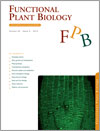
Functional Plant Biology
Volume 40 Number 3 2013
FP12233Sap-flux density measurement methods: working principles and applicability
Sap-flow measurements have become increasingly important in plant science since the early experiments based on the application of dyes. Given the recent developments in heat based sap-flux density methods, this review aims at synthesising the existing but scattered literature. By unveiling the measurement principles and addressing some common pitfalls, users are enabled to make a well founded choice, whether for practical applications or fundamental research questions and further improvement in sap-flow methodology is encouraged.
FP12248Dissecting the mechanism of abscisic acid-induced dynamic microtubule reorientation using live cell imaging
Abscisic acid (ABA) is a plant hormone involved in signalling developmental and environmental cues to cells and can trigger the reorientation of the microtubule cytoskeleton. Our aim was to dissect the physical mechanism behind this process. We found that changes in microtubule growth rate and stability accompany the progressive rearrangement of the microtubules. These changes may reflect the underlying mechanism on how ABA influences plant growth and development at the cellular level.
FP12127Nitrogen tolerance in the lichen Xanthoria parietina: the sensitive side of a resistant species
Lichens are one of the most sensitive components of the ecosystem to nitrogen pollution. We found that nitrogen tolerance is not only a species-specific feature, but can also result from adaptation to long-term nitrogen exposure. These results are important in understanding the effects of chronic pollution, linking physiological response and ecological consequences.
FP12255Seed reserve dependency of Leucaena leucocephala seedling growth for nitrogen and phosphorus
After seed mineral reserves expire, Leucaena leucocephala seedlings form associations with N-fixing bacteria and with mycorrhizal fungi that aid in phosphorus uptake. We determined experimentally that seed nitrogen is depleted several weeks before P, so seedlings need to invest in N-fixing bacteria first, a process that requires P that seed reserves can still supply. These results are relevant for understanding nutrient-acquisition strategies during establishment of L. leucocephala, which is invasive outside its native range.
FP12201Heteroblasty in bromeliads – anatomical, morphological and physiological changes in ontogeny are not related to the change from atmospheric to tank form
Heteroblasty – an abrupt change in gross morphology during ontogeny – is common in many Bromeliaceae. In this study we set out to understand its functional importance. We show that size-related variation in anatomical and physiological parameters is common, but unrelated to the conspicuous step change in gross morphology. These findings suggest that previous notions of the functional relevance of heteroblasty in bromeliads should be reconsidered.
FP12133Simulation of inflorescence dynamics in oil palm and estimation of environment-sensitive phenological phases: a model based analysis
Inflorescence abortion and sex determination are the main processes affecting yield in oil palm; these are determined by environmental stresses and source–sink imbalance occurring during specific phases of inflorescence development. Model-based analyses and parameter optimisation procedures were used to estimate the timing of the specific environment-sensitive phases. This study demonstrates that simple modelling approaches can help extracting ecophysiological information from simple field observations on complex systems.
FP12243Plant growth co-ordination in natura: a unique temperature-controlled law among vegetative and reproductive organs in mango
Temperature is a major driver of plant growth and its effects are usually studied on the leaves of annual plants. This study describes the effect of temperature on the growth of three organs of mango trees: the vegetative axis, the leaf and the inflorescence axis. Results showed that a common temperature-controlled allometric constraint is probably underlying the growth of all these organs.
FP12143Transcriptome identification of the resistance-associated genes (RAGs) to Aspergillus flavus infection in pre-harvested peanut (Arachis hypogaea)
Aflatoxin contamination caused by Aspergillus favus severely impairs peanut productivity and affects human and animal health. Transcriptome analysis using a microarray identifies candidate genes and pathways underlying the resistance mechanism in peanut was conducted, leading to an enhanced understanding of pre-harvest peanut–A. flavus interaction. This study will facilitate to develop peanut cultivars with resistance to pre-harvested aflatoxin contamination in future breeding programs.
FP12253AtMYB44 positively modulates disease resistance to Pseudomonas syringae through the salicylic acid signalling pathway in Arabidopsis
Transcriptional regulation of gene expression that is largely mediated by transcription factors plays a key role in the plant immunity responses. In this study, we found one MYB transcription factor AtMYB44 involved in plant defense response against a biotrophic pathogen. We demonstrate the regulation roles of AtMYB44 in plant defense are mainly through the salicylic acid signalling pathway.



